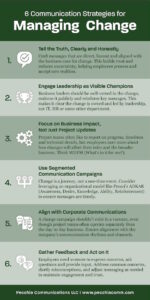4
2025

By Dan Pecchia
Successful organizational change is built on clear, strategic communication. Without it, even the best-planned changes can face resistance, confusion or outright failure.
Organizations introducing new technology, new ways of working or other transformational changes over time need communications that not only inform but also engage and inspire. Here are six essential strategies to guide project teams implementing major changes.
1. Tell the Truth, Clearly and Honestly
Transparency is critical when major changes are rolling out. Employees deserve to know what’s happening, why it’s happening and how it will impact them.

For a downloadable PDF of this infographic, click here.
Avoid sugar-coating bad news or omitting key details. Instead, craft messages that are direct, honest and aligned with the business case for change. This builds trust and reduces uncertainty, helping employees process and accept new realities more effectively, and can also inspire advocacy for change.
2. Engage Leadership as Visible Champions
People look to their leaders for guidance and reassurance during times of change. Ensuring that executives and managers are actively engaged in the communication process makes a significant difference in acceptance and adoption.
Leaders should be well-versed in the change initiative, endorse it publicly and reinforce key messages in their interactions. This prevents the perception that change is something being imposed (for example: “IT is doing this to us”) and makes it clear the change is owned and led by business leaders.
3. Focus on Business Impact, Not Just Project Updates
Project teams often like to report on progress, timelines and technical details, but employees care more about how changes will affect their roles and the broader business. Think WIIFM (What’s in it for me?). Shift the focus of communication from project updates to the real-world impact on the business.
Ensure that messaging answers key questions: What does this mean for daily operations? How will it improve efficiency? What steps can I take to get ready?
4. Use Segmented Communications Campaigns
Change is a journey, not a one-time event. Employees experience change in phases — awareness, understanding, adoption and reinforcement — so communication should be planned accordingly. A one-size-fits-all approach won’t work, and neither will a tell-us-everything-today program.
Consider leveraging an organizational model like Prosci’s ADKAR (Awareness, Desire, Knowledge, Ability, Reinforcement) to ensure messages are relevant at each stage of the transition. Segmenting communications will help ensure employees receive the right information at the right time.
5. Align with Corporate Communications
An organizational change campaign shouldn’t exist in a vacuum, even though project teams managing significant changes often do much of their work separately from the day-to-day business. Comms that are integrated with broader corporate communications ensure consistency and maximize reach.
Leverage the channels through which employees normally consume corporate information — whether it’s town hall meetings, email newsletters, collaboration tools or leadership briefings — to deliver key messages effectively. Ensuring alignment with the company’s communication rhythms helps reinforce the message and prevent information silos.
6. Gather Feedback and Act on It
Communication should be a two-way street. Employees need avenues to express concerns, ask questions and provide input. Surveys, pulse checks and direct insights from managers who understand their teams’ concerns are invaluable tools.
But gathering feedback isn’t enough — leaders must act on it. Address common concerns, clarify misconceptions and adjust messaging or support strategies as needed to maintain engagement and trust throughout the change process.
Final Thoughts
Organizational change isn’t easy, but a well-executed change management campaign with strong communications can make all the difference.
By ensuring transparency, leadership engagement, a focus on business impact, proper timing, alignment with corporate communications and feedback opportunities, organizations can drive smoother transitions and greater adoption of change initiatives.
Remember, change is not just about processes — it’s about people. The more effectively you communicate, the more successful your transformation will be.
______
Dan Pecchia is a Prosci-certified change management consultant with more than 25 years of communications experience. Since 2006, he has served in comms or change management roles on 16 business transformation projects.
Latest Posts
- 3 Media Relations Guidelines for an Era of Growing Distrust May 5, 2025
- Brighten Up Your Brand: 3 Tips for a Summer Messaging Makeover May 5, 2025
- Pecchia Comm Lands 18th Major Change Engagement May 5, 2025
- Student Journalism Awards Lead Press Club’s Plans for 2025 March 6, 2025
- Pecchia Comm Plans $20K Grant to Celebrate 20th Anniversary February 26, 2025
- Power of Print Still Endures in Employee Comms February 5, 2025
- 6 Essential Communications Strategies for Managing Organizational Change February 4, 2025
- Factory Work Instructions Drive Compliance, Consistency February 3, 2025
6725 Pheasant Run Drive | Youngstown, Ohio 44406 | Privacy Policy

